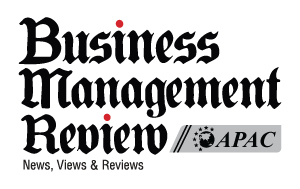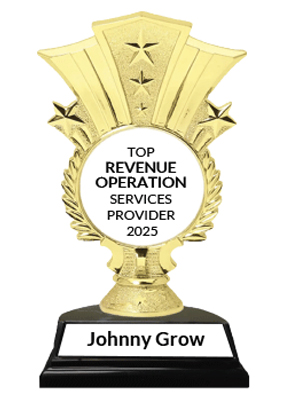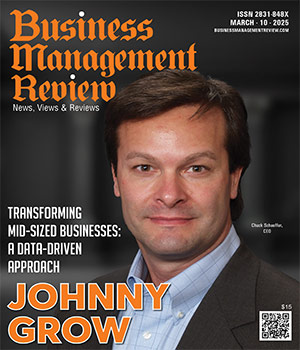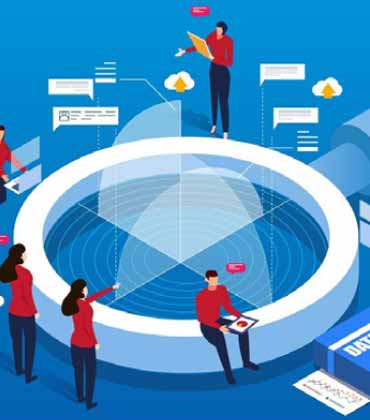Thank you for Subscribing to Business Management Review Weekly Brief
I agree We use cookies on this website to enhance your user experience. By clicking any link on this page you are giving your consent for us to set cookies. More info
Business Management Review: Speials Magazine
Each business dreams of growth, but what does that really mean? For some, it’s about expanding sales and gaining new customers. Others see growth in improving operations to boost profits. Then there are businesses planning for the future, aiming to maximize their market value for a sale or merger. The challenge lies in defining what growth truly means for each company—and determining how to achieve it. This is where Johnny Grow steps in. Dubbed the “revenue architect,” the company helps businesses uncover their growth priorities and transform them into actionable, science-backed plans. It drives revenue, profits, and market capitalization by bridging the gap between large-scale expertise and the needs of mid-market businesses. Unlocking Growth Potential Johnny Grow treats growth as a measurable science rather than an art, applying precision and data-driven methodologies to deliver personalized solutions for mid-sized companies. Its approach focuses on three key areas: implementing strategies to acquire new customers and maximize opportunities with existing ones, increasing efficiency and margins through data-driven insights, and preparing businesses for future liquidity events by optimizing their valuation. These services are delivered with a deep understanding of mid-market challenges, such as smaller budgets and leaner teams, making Johnny Grow a true partner for companies looking to scale. At the core of Johnny Grow’s methodology is a proprietary framework called Ascend, which identifies three ways to grow revenue: customer acquisition, customer expansion, and strategic pricing. "We believe revenue and profit growth are science-based efforts—data-driven, fact-based, and measurable. That’s why we’ve developed our growth accelerator methodology," says Chuck Schaeffer, CEO of Johnny Grow. The process begins with a deep dive into each client’s current operations. This involves assessing what works, identifying gaps, and creating a roadmap aligned with their specific goals—whether focused on revenue, profit, or valuation growth.
The Business Research Company (TBRC), a leading market research firm, combines human-centered research with technological innovation to unlock new opportunities for efficiency and growth. It offers market reports, customized research and knowledge process outsourcing (KPO) services. Its expert research consultants use in-depth interviews with industry experts, advanced research and artificial intelligence (AI) capabilities to provide businesses with a comprehensive understanding of markets across the globe, helping them gain a competitive edge. “In a world overflowing with information, our mission is to leverage human intelligence with advanced technology to extract clarity and deliver insights that truly matter,” says Oliver Guirdham, managing director. TBRC leverages AI in transformative ways to augment its research capabilities and enhance the value it delivers to clients. One significant application is to supplement traditional research methods, such as web research, database analysis and the review of annual filings. TBRC’s hybrid approach allows it to identify new and often overlooked data sources for further investigation, thereby ensuring all critical information is considered
Since 1980, Armstrong & Associates (A&A) has been the go-to authority in third-party logistics (3PL), delivering the insights and strategies that drive organizations forward. With expertise in market intelligence, logistics outsourcing, strategic planning, mergers and acquisitions, and operational benchmarking, it helps logistics providers, shippers, and investors stay ahead in the supply chain landscape. Armed with a database of over 3,000 third-party logistics providers (3PLs) and exclusive industry reports, A&A doesn’t just analyze trends—it sets them. “Our mission is to provide information nobody else has regarding third-party logistics,” says Evan Armstrong, CEO. A&A delivers on this promise by providing businesses access to comprehensive data on the Third-Party Logistics Market, global logistics, warehousing, domestic and international transportation management, last-mile delivery, and specialized transportation. As part of its subscription-based model, it also offers an online guide featuring profiles of over 800 3PLs. This resource is widely used by shippers looking to outsource logistics functions, 3PLs, strategic consulting firms, investment banks, and private equity companies to identify top partners and investment opportunities in logistics. In strategic consulting, it helps 3PL providers develop growth strategies related to market positioning, customer targeting, service differentiation, digitalization, pricing, and organizational alignment. Using detailed market research and competitive benchmarks, A&A conducts SWOT analyses to identify growth opportunities and areas for optimization. These insights drive the development of tailored business plans and go-to-market strategies specific to each provider’s needs. It supports shippers outsourcing critical logistics functions like transportation management and warehousing to top-performing 3PL providers. The process includes reviewing current operations, analyzing pricing models, and developing Requests for Proposals (RFPs) to identify the most suitable provider. A&A also helps large shippers benchmark their 3PL pricing for cost efficiency and competitive advantage. It is also frequently engaged as an expert witness in legal cases involving logistics operations and market practices.
In a world flooded with traditional market research methods and the growing influence of AI, many companies still rely on outdated strategies that focus solely on surface-level data. Enter Human Branding—a revolutionary force that stepped into an industry bogged down by conventional thinking and completely redefined the landscape. Human Branding has always stood apart from traditional market research, challenging the norms that dominated the industry. This outsider perspective has proven to be the company’s greatest strength, allowing it to uncover insights that others often overlook. From the very beginning, Human Branding understood that true insight into human behavior goes far beyond what is immediately visible. Human Branding didn’t just accept the status quo—it redefined the entire landscape of market research. The company has spent nearly two decades dismantling the limitations of traditional market research, delivering insights that speak to the emotional, psychological, linguistic, cultural, and contextual factors driving human decisions. Its clients include Fortune 500 players across pharma, health, wellness, and packaged goods—industries where human behavior is complex, highly emotional, and often misunderstood. Human Branding’s ability to step outside the boundaries of traditional approaches became its defining advantage. The company didn’t simply follow the well-worn path—it forged a new one, offering a profound shift in how businesses understand their audiences. Recognizing the failings of traditional research, Human Branding pioneered a new way of thinking. It combined qualitative and quantitative research with ethnographic methodologies and proprietary behavioral science frameworks, unlocking insights that go far beyond the obvious. These insights penetrate the deeper emotional and psychological drivers behind human choices, transforming basic data into powerful, human-centered strategies that resonate on a much more profound level. In today’s high-stakes marketing environment, where data pours in from every touchpoint and artificial intelligence promises instant answers, a surprising trend is emerging: a return to human understanding. Not just customer feedback or consumer sentiment, but a deeper, more rigorous decoding of human behavior, rooted in anthropology—the original behavioral science. While AI’s capacity to process vast amounts of data is groundbreaking, it has a crucial limitation: it cannot grasp the complexity of human behavior, particularly the emotional and subconscious factors that influence decisions. Human Branding offers more nuanced insights that go beyond numbers, revealing the hidden layers of human motivation that drive decision-making. Human Branding’s approach is designed to reveal not just what people do, but why. It’s a discipline that sits at the intersection of data and meaning—and it’s proving to be a powerful strategic asset in an increasingly commoditized insights landscape. In the words of Johanna Faigelman, founder and CEO of Human Branding, “We’re not just about collecting data; we’re about understanding what drives people on a deeper, more emotional level. Anthropology allows us to dig into the complexities of human behavior—the beliefs, values, emotions, and influences that shape decisions. This helps businesses craft strategies that don’t just talk at consumers, but resonate with them.”
CXO INSIGHTS

Strategies for Building Strong Relationships and Driving Innovation
Carson Del Campo, Customer Success Manager, Wise [LSE: WISE]

How Midsize Banks Can Thrive Through Research and Product Design in the Digital Transformation Era
Eylul Pierce, AVP, Digital Product Manager II, Tri Counties Bank

The Changing Role Of Finance, and FP&A In The Modern Business Environment
Christina Homburg, Global Head of M&A, Marley Spoon

Marketing For The New Digital Shelf
Chip Schuman, Senior Vice President of Marketing, Consumer Products, Sargento Foods Inc.

Why Marketing Is A Must-Have For Small Business Growth
Mark Cohen, Senior Vice President, Marketing Manager - Advisory Services, Mesirow
IN FOCUS
Emerging Market Research Trends in the Future
Emerging market research trends are set to redefine the way businesses understand, analyze, and respond to consumer behavior, market trends, and competitive landscapes.
A Step-by-Step Guide to Revenue Operations Implementation
Aligning your revenue process across sales, marketing, and relationships is key to sustainable growth in today's competitive market. Companies with a strong RevOps function are seeing faster revenue growth, shorter sales cycles, improved customer satisfaction, and streamlined operations.
EDITORIAL
Driving Growth through Data-Driven Strategies
In today’s hyper-competitive business landscape, companies must harness every possible advantage to drive sustainable growth. Two critical disciplines—Market Research (MR) and Revenue Operations (RevOps)—play pivotal roles in ensuring businesses remain datadriven, customer-focused, and operationally efficient. While Market Research provides deep insights into consumer behavior, industry trends, and competitive landscapes, Revenue Operations ensures that these insights are effectively implemented across sales, marketing, and customer success functions. The synergy between these two domains can empower businesses to make informed decisions, optimize performance, and maximize revenue. Market Research is the foundation of any successful business strategy. By analyzing customer preferences, industry shifts, and competitive positioning, organizations gain a clearer picture of market demands. It involves various methodologies, such as surveys, focus groups, competitive analysis, and data analytics, to gather actionable intelligence. A customer-centric strategy is built on the foundation of understanding the audience, allowing businesses to tailor products and messaging to meet specific needs. Competitive intelligence plays a crucial role in identifying market gaps and analyzing competitor strategies, enabling organizations to differentiate effectively. When Market Research and Revenue Operations work in tandem, businesses unlock a powerful competitive advantage. Informed sales and marketing strategies benefit from market insights that help RevOps teams refine go-to-market approaches, ensuring that campaigns and outreach efforts are data-backed. Personalization and an enhanced customer experience become possible when businesses understand consumer needs, leading to higher conversion rates and improved customer satisfaction. Agility and adaptability are strengthened through continuous feedback loops between MR and RevOps, enabling businesses to quickly adjust to market changes and optimize revenue strategies. Ultimately, bridging the gap between research and execution ensures that business investments yield maximum returns, enhancing long-term growth and profitability. Market Research and Revenue Operations are no longer standalone functions; their integration is critical for sustainable growth. While Market Research provides the ‘why’ behind customer behaviors and market trends, RevOps ensures the ‘how’ in operationalizing these insights for revenue generation. Companies that leverage the combined power of MR and RevOps can create agile, customer-centric strategies that drive profitability and long-term success.

However, if you would like to share the information in this article, you may use the link below:
https://www.businessmanagementreviewapac.com/edition/March-10-2025-6.html










